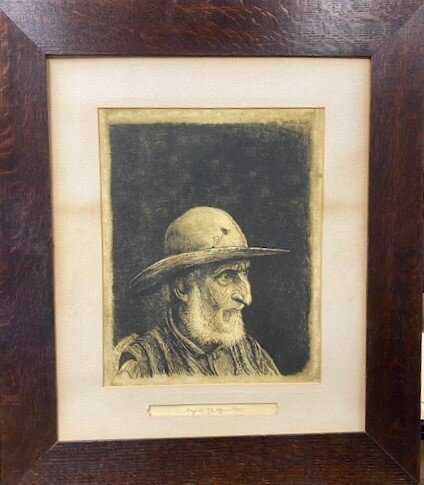uncle alvah
Alvah Dunning, photograph by Seneca Ray Stoddard, ca. 1891, courtesy the Adirondack Experience
uncle alvah
By Robert Engel
Great Camp Sagamore’s Historian
The lone pioneer stepping beyond the frontier into an unmapped wilderness is a key figure in the American myth. Survival depended on self-reliance, sound woodcraft, sharp aim, and luck. As time and civilization advanced, the old pioneer became a curiosity and, eventually, a legend.
Like cowboys and mountain men, the early Adirondack guides have become storybook characters. With a rusty jackknife and one soggy match, they could build you a dry shelter and a crackling fire while telling tall tales and cooking your trout.
Alvah Dunning, who could draw a mink out of its hiding place by chittering convincingly, was considered to be one of the greats.
Like any legend, Dunning’s real story is far from perfect. He was born in 1816 near Piseco Lake in what would become the southern Adirondacks. His family persisted on hunting and trapping; Alvah shot his first moose when he was 11. He came to the deep woods as a young man on the run after committing a violent crime. A phrase returned to often by those that knew him was “ornery cuss.”
For years, he was the lone permanent resident on Blue Mountain and Raquette Lakes. In the summers of 1867-9, he shared Raquette Lake with a Boston preacher named William H.H. Murray. The two got along okay until Murray published a book, Adventures in the Wilderness, which mentioned Dunning and drew thousands of inexperienced tourists.
Wealthy “sports” sought Dunning’s services as a guide. He cared little for their money and less for their company. “They pay me well enough, but I’d rather they’d stay out of my woods… They’re mostly durned fools, anyhow!”
Alvah Dunning, etching by Arpad Gerster after photograph by Seneca Ray Stoddard, 1892, courtesy the Adirondack Experience
Dr. Arpad Gerster was a leading surgeon in New York City who summered on Raquette Lake in the 1890s. Locals would paddle up to Gerster’s dock with a bone to set or needing med’sins for rheumatiz or collywobbles. He kept diaries that he filled with drawings, including this sketch of Alvah Dunning. The story goes that Dunning lost his watch in the lake while fishing with Gerster. The doctor drew Dunning’s profile from a recent photograph and sold etchings as a “quiet” fundraiser. He then presented a new gold watch to Dunning who fainted on the spot from gratitude.
Dunning could be your best friend or worst enemy. Camp builder William West Durant was at times both. Dunning’s land on Osprey Island in Raquette Lake, which he claimed by squatter’s rights, was bought out from under him by Durant’s father, Thomas C. Durant. The elder Durant then tried to evict Dunning, who vowed to shoot any man who dared step foot on his island.
Dunning relented when Durant’s mother Heloise intervened with tea and cookies. He then built a cabin on Eighth Lake. When that became too crowded, he moved to a secluded spot on Raquette near the Browns Tract Inlet. That was 1896. In 1899, a man knocked on Dunning’s cabin door to say that his patch of land was about to be the site of a railroad station and the new Village of Raquette Lake.
Adirondack historian Alfred Donaldson wrote that the announcement of the train coming “affected (Dunning) much as if he had been hit by it.”
By then, Dunning was 83. The locals called him Uncle Alvah. Donaldson quoted Dunning, “I guess I’ve lived too long…if I don’t slip my wind pretty quick, I guess there ain’t goin’ to be no wilderness to die in…out o’reach of tootin’ steamboats and screechin’ en-gines.”
Dejected, Dunning moved to Syracuse to live with his sister. He attended a sportsman show in New York City in 1902 where he was presented as a dying breed - the last of the great Adirondack guides. On his way back home, Dunning spent the night at a Utica inn where he blew out the flame from the room’s gas light but failed to fully shut the valve. His body was found the next morning.
Professional guiding in the Adirondacks has made a comeback. Jen Maguder, Great Camp Sagamore’s programs director, has her license. Now guides are more likely to teach you about fly fishing and woodcraft, but they’re still happy to tell tall tales around the fire.
Alvah Dunning in guide boat, WW Durant at base of stairs, Durant’s mother Heloise sitting on porch, Sagamore Lodge, photograph by Seneca Ray Stoddard, 1899
Learn more . . .
Does Alvah Dunning remind you of any other characters in American history, real or fictional?
The tourists drawn by W.H.H. Murray’s Adventures in the Wilderness had a nickname, what was it?
What is meant by squatter’s rights?
What the heck are collywobbles?
Arpad Gerster sketch of "Uncle" Alvah Dunning
GREAT CAMP SAGAMORE’S ANNUAL GALA & BENEFIT JUNE 17-24
Visit https://GCS2020Gala.givesmart.com to view this auction item and more. Online bidding starts June 17. Register for free now!
Museum-quality print, archival paper, copied from original etching - one of two known to exist. Ca.1905 Arts & Crafts oak frame with period glass and gold leaf plaque.




